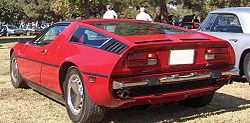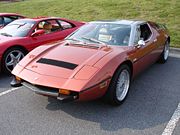- Maserati Bora
-
Not to be confused with Volkswagen Bora.
Maserati Bora 
Manufacturer Maserati Production 1971-1978 (Bora 4.7 L)
289 produced[1]
1974-1978 (Bora 4.9 L)
275 produced[2]Predecessor Maserati Ghibli Successor Maserati MC12 Body style 2-door coupe Layout RMR layout Engine 4.7 L 4719 cc V8
4.9 L 4930 cc V8Transmission 5-speed manual Wheelbase 2,600 mm (102.4 in) Length 4,335 mm (170.7 in) Width 1,738 mm (68.4 in) Height 1,138 mm (44.8 in) Curb weight 1,520 kg (3,351 lb) Related Maserati Merak Designer Giorgetto Giugiaro The Maserati Bora is a Maserati two-seater coupe powered by a V8 engine mounted amidships. Produced from 1971 to 1978, it had a top speed of 174–177 miles per hour (280–285 km/h).[1][2]
Contents
History
Shortly after Citroën took a controlling interest in Maserati in 1968, the concept of a mid-engined two-seat sports car was proposed. Lamborghini and De Tomaso already had the Miura and Mangusta whilst Ferrari were known to be developing their own mid-engined contender. Initially known as Tipo 117 and later the Bora, the Maserati project got underway in October 1968 and a prototype was on the road by the summer of 1969. Shown in its final form at the Geneva Salon in March 1971,[3] the first customer cars had been delivered before the end of the year. Maserati struggled after being bought by De Tomaso in 1975, and the Bora was discontinued in 1978.
Design
A combined steel monocoque chassis and body featured a tubular steel subframe at the back for the engine and transmission. Suspension was independent all round (a first for a Maserati road car) with coil springs, telescopic shocks and anti-roll bars. The development prototype and the broadly similar show car first seen at the 1971 Geneva Motor Show featured MacPherson Strut based front suspension, but this was abandoned for production because, installed in combination with very wide front tires and rack-and-pinion steering, the strut-based solution produced severe kickback.[4] For the production cars Maserati reverted to a more conservative wishbone front-suspension arrangement.[4]
Citroën's advanced high pressure hydraulics were adopted to operate the ventilated disc brakes, the brake, clutch and throttle pedal box, the driver's seat and the retractable headlights. Wheels were 7.5 x 15-inch (380 mm) Campagnolo light alloy rims with distinctive removable polished stainless steel hubcaps in the earlier automobiles and Michelin XWX tyres.
Engine-wise, Maserati decided to install a subtly uprated version of their familiar DOHC 90° V8, displacement having been 4719 cc thanks to a bore and stroke of 93.9 x 85 mm. Mounted longitudinally, compression was set at 8.5:1 and with four Weber 42 DCNF downdraught carbs and electronic Bosch ignition, the Bora could boast 310 bhp (230 kW) at 6000 rpm. Great attention was paid to reducing noise and vibration, the engine and five-speed ZF transaxle being mounted on a subframe attached to the monocoque via four flexible mounts. Additionally, the aluminium engine cover came trimmed in deep-pile carpet and the window between the passenger's compartment and the engine bay had double-glazing for noise suppression, a feature ahead of its time. The body was created by Giorgetto Giugiaro for Ital Design, fabrication of the all-steel panels being contracted to Officine Padane of Modena.[3]
The Bora was an interestingly designed car. Standing 1138 mm high, perhaps the most distinctive details were the brushed stainless steel roof and windscreen pillars. Inside, the bucket seats, dash, door trim, centre console and rear bulkhead were trimmed in leather, electric windows having been standard, most cars also getting air conditioners. The steering column was tailored for rake and reach, the driver's seat being height adjustable only. Instead, high pressure hydraulics moved the pedal box, consisting of the brake, clutch and throttle pedals, forwards and backwards by around three inches (76 mm) , a first such application in the world for a production car. Weighing in at 1520 kg (around 180 kg heavier than the Ghibli), top speed was 165 mph (266 km/h) whilst 0-60 and 0-100 took 6.5 and 14.6 seconds respectively. The first Boras were delivered to customers in late 1971, only minor production changes being gradually phased in thereafter. These included front lids hinged at the front, pop-up headlights with rounded inside corners, a rectangular front lid-mounted grille and finally, matte black louvres on the sail panels. From 1973, as the 4.7-litre engine hadn't been homologated in North America, Boras destined for the United States were fitted with emissions-equipped 4.9s similar to those found in US-bound Ghiblis. Output was 280 bhp (210 kW) at 6000 rpm, only 30 bhp (22 kW) less than the Euro-spec derivative, changing the zero to sixty time to 7.2 seconds and the quarter mile to 15.2 seconds.
However, of more concern were the unpopular bumpers that normally had to be added in order to meet US DOT safety legislation. Three years later, a 4.9-litre engine became standard on all Boras, displacement having been stroked from 85 to 89 mm, this resulting in a 4930 cc. With compression set at 8.75:1, output was 10 bhp (7.5 kW) up on the 4.7 with 320 (330 Europe) bhp at 5500 rpm.
Production ran from 1971 to 1978, 524 Boras eventually being built, 289 of which were 4.7s and the remaining 235, 4.9s.
The Bora had a twin, the Merak, which used the same bodyshell and a smaller Maserati V6 engine, also used in the Citroën SM.
References
- ^ a b "Maserati Bora 4.7". maserati.com. http://www.maserati.com/maserati/en/en/index/models/heritage/Gran-Turismo/m-bora4-7.html. Retrieved 2009-07-15.
- ^ a b "Maserati Bora 4.9". www.maserati.com. http://www.maserati.com/maserati/en/en/index/models/heritage/Gran-Turismo/m-bora4-9.html. Retrieved 2009-07-15.
- ^ a b "Maserati's History". Maserati web site. http://www.maserati.com/maserati/en/en/index/passion/company/history/recent-years.html. Retrieved May 21, 2009.
- ^ a b "Continental Diary". Motor: pages 30–31. date 10 July 1971.
External links
Maserati 1946-1969 1970-1979 1980-1999 2000-present Racing Vehicles Concept Cars Maserati road car timeline, 1950s–present Type 1950s 1960s 1970s 1980s 1990s 2000s 2010s 0 1 2 3 4 5 6 7 8 9 0 1 2 3 4 5 6 7 8 9 0 1 2 3 4 5 6 7 8 9 0 1 2 3 4 5 6 7 8 9 0 1 2 3 4 5 6 7 8 9 0 1 2 3 4 5 6 7 8 9 0 1 2 Ownership Orsi family Citroën De Tomaso Fiat S.p.A. Executive Biturbo Luxury Quattroporte QP II QP III QP IV QP V GT A6 3500 GT Sebring 228 Ghibli II 3200GT Coupé 5000 GT Ghibli Khamsin Shamal GranTurismo Mistral Karif 2+2 Mexico Kyalami Indy Mid-engine Bora MC12 Merak SUV Kubang Categories:- Maserati vehicles
- Rear wheel drive vehicles
- Rear mid-engine, rear-wheel drive vehicles
- Sports cars
- 1970s automobiles
- Vehicles introduced in 1971
Wikimedia Foundation. 2010.


